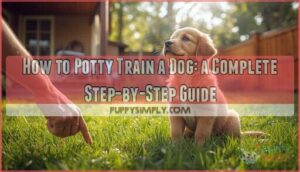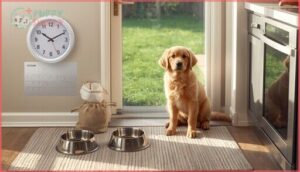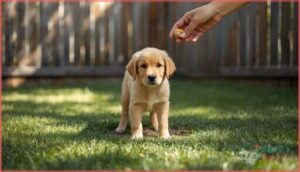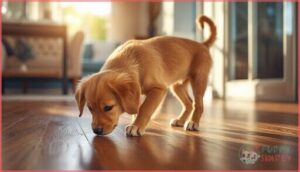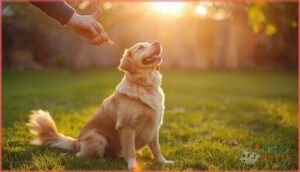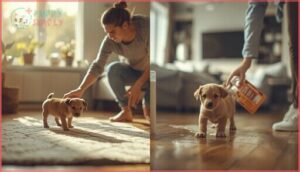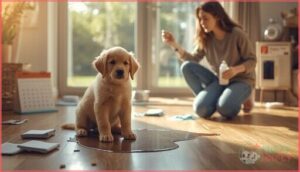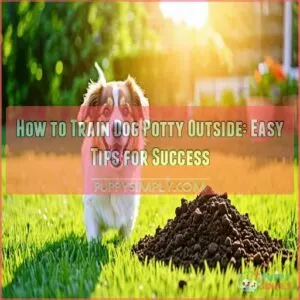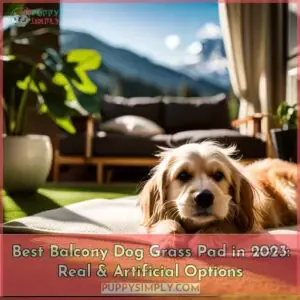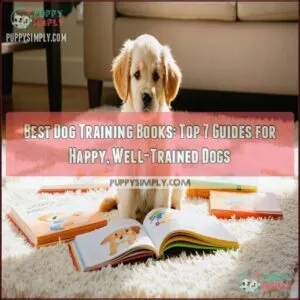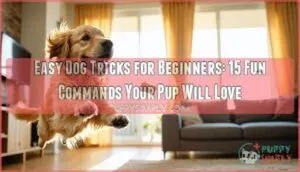This site is supported by our readers. We may earn a commission, at no cost to you, if you purchase through links.
Your new puppy just peed on the carpet for the third time today, and you’re wondering if you’ll ever reclaim your living room. The truth is, most dogs can master potty training in three to six months with the right approach—but the timeline depends entirely on consistency, patience, and understanding what your dog actually needs.
Toy breeds require bathroom breaks every hour, while larger puppies can hold it a bit longer, and missing these windows turns accidents into habits.
The good news? Once you establish a predictable routine and learn to read your dog’s signals, those frustrating puddles become rare slip-ups instead of daily disasters. Success comes down to setting up systems that work with your dog’s natural instincts, not against them.
Table Of Contents
- Key Takeaways
- Preparing for Successful Potty Training
- Establishing a Consistent Potty Training Routine
- Positive Reinforcement and Training Techniques
- Preventing and Managing Potty Training Accidents
- Troubleshooting Common Potty Training Challenges
- Frequently Asked Questions (FAQs)
- How long does it take for a dog to be fully potty trained?
- What’s the easiest way to potty train a dog?
- How do you train a dog from peeing and pooping in the house?
- What age do dogs learn to potty train?
- How can I tell if my dog is housebroken?
- What age is best to start potty training?
- How do I potty train an older dog?
- What are signs of a potty training regression?
- How long should potty training sessions last?
- Can dogs be trained to use indoor toilets?
- Conclusion
Key Takeaways
- Most dogs master potty training in 4-6 months with consistent routines, though toy breeds need bathroom breaks every hour while larger puppies can hold it longer, and missing these windows turns accidents into habits.
- Success depends on establishing a predictable feeding schedule and designated potty spot, then rewarding your dog within 1-2 seconds of elimination to create clear associations between action and praise.
- Supervision and proper crate sizing prevent accidents more effectively than punishment ever will, since yelling triggers fear and slows progress while positive reinforcement builds trust and confidence.
- Watch for behavioral cues like sniffing, circling, or pacing that signal your dog needs to go within minutes, and if accidents persist after two weeks of consistent effort, schedule a vet check to rule out medical issues like urinary tract infections.
Preparing for Successful Potty Training
Before you bring your dog home or start the training process, you need to set yourself up for success. The right mindset, a clear understanding of what your dog needs, and a few key supplies will make everything easier.
Let’s break down the three essentials that lay the foundation for effective potty training.
Setting Realistic Expectations
Realistically, potty training doesn’t happen overnight—puppies usually need 4–6 months, while adult dogs may master house training in 1–4 weeks. Expect some accidents during those first couple of weeks as your dog learns the ropes. Progress depends on consistency, health factors, and environmental influences like household changes. Understanding language resources can help dog owners communicate more effectively with their pets.
- Track days with zero indoor accidents over a two-week window
- Monitor time between bathroom breaks relative to meals and water
- Watch for gradual improvement in bladder control, especially overnight
- Document progress to spot patterns and adjust your approach
- Remember that puppy development stages affect training speed naturally.
Understanding Your Dog’s Age and Breed Needs
Age and breed size both shape how you approach housebreaking techniques. Puppies under six months need potty breaks every 1–2 hours because their bladders are still developing, while toy breeds require even more frequent trips than large dogs throughout their lives.
Track your dog’s developmental milestones and adjust your schedule accordingly—canine behavior shifts during teething, adolescence, and health changes can all trigger temporary setbacks in puppy training.
Consistency is key to successful training, and using clear science methods can help you understand your dog’s needs.
Gathering Essential Potty Training Supplies
You’ll save yourself frustration by stocking up before day one. Pick a leak-proof crate sized so your dog can stand and turn comfortably—too much space invites accidents during crate training.
Grab potty pads for indoor setups, an enzyme-based odor remover that actually breaks down urine, and a puppy collar with a sturdy leash for outdoor trips.
Consistent portions mean predictable potty times, so add a measuring scoop to your list.
Establishing a Consistent Potty Training Routine
Consistency is your strongest tool for potty training. Dogs thrive on predictable patterns, and a solid routine removes the guesswork for both of you.
Let’s break down the three core elements that will set your training up for success.
Creating a Regular Feeding and Potty Schedule
You’ll cut accidents by 70% in the first week by feeding your dog at the same times every day. Most puppies need to go within 10 to 20 minutes after eating, so plan potty breaks around meal frequency.
Portion meals properly for your dog’s age and breed, skip free-feeding, and limit water 1–2 hours before bedtime. Consistency in dietary routines makes bathroom routines predictable.
Choosing and Introducing a Designated Potty Spot
Your dog needs one reliable place to go, every single time. Pick a spot outdoors within easy reach, or use an indoor pad if weather or mobility limits access. Keep it away from food and water zones, and always use the same surface texture or scent cue to trigger the right behavior.
Follow these steps to lock in spot consistency and prevent accidents:
- Introduce the spot immediately after meals, naps, and play sessions
- Pair a simple cue word like “go potty” with every successful elimination
- Reward instantly with high-value treats to strengthen the association
- Clean thoroughly with enzyme-based cleaners if accidents happen near the spot
- Maintain access to the spot at all times during housebreaking
Consistency in potty spot selection builds faster learning and fewer surprises.
Recognizing Signs Your Dog Needs to Go
Watch for sniffing, circling, or sudden pacing—these potty cues tell you elimination is minutes away. Most puppies need to go within 10–20 minutes of waking or eating.
Your dog’s body language speaks volumes: whining near doors, restless movement after meals, or focused gazing at floor corners all signal physiological urgency.
Catch these canine communication signs early, and you’ll prevent accidents while accelerating housebreaking success.
Positive Reinforcement and Training Techniques
Your dog wants to do the right thing—your job is to show them what that looks like and make it worth their while. Positive reinforcement turns potty training from a confusing guessing game into a clear path your dog actually wants to follow.
Here’s how to use rewards, commands, and patience to build habits that stick.
Using Treats, Praise, and Rewards Effectively
Rewards turn good behavior into habit—but timing and delivery make or break your reward system. You need to nail the basics right from day one to lock in reliable puppy potty training results.
- Give treats within 1–2 seconds of your dog finishing outdoors—instant reward timing creates the clearest connection between action and praise.
- Choose small, soft treats that won’t slow down training or overfeed your pup during those critical first weeks.
- Pair enthusiastic verbal praise with every treat to build a multi-layered motivation strategy your dog can’t ignore.
- Stay consistent with your reward delivery—same treat, same tone, same spot—so confusion never derails your dog training techniques.
Teaching a Potty Command
Your potty cue acts like a trigger—one word that tells your dog exactly what you expect. Pick a simple term like “potty” or “go,” then say it calmly as elimination starts.
Pair command consistency with reward timing within 2 seconds of success. Stick to one designated training environment and watch elimination signals closely.
These housebreaking techniques build rock-solid puppy potty training habits fast.
Avoiding Punishment and Negative Associations
Yelling or rough handling backfires—punishment-based training methods trigger fear and aggression while slowing your progress. When accidents happen, stay calm and redirect quietly.
Punishment backfires in potty training—stay calm during accidents and redirect quietly instead of yelling
Positive reinforcement and trust building work faster than scolding ever will. Your reward systems teach what to do, not just what to avoid.
Calm correction paired with fear reduction creates confident housebreaking techniques that stick for life.
Preventing and Managing Potty Training Accidents
Accidents are part of the process, so don’t let them throw you off track. The key is staying one step ahead through smart supervision and knowing how to respond when things go wrong.
Here’s how to minimize mistakes and handle them like a pro when they happen.
Supervising and Confining Your Dog
You can’t potty train what you can’t see. Direct supervision means keeping your dog within a few feet, using a leash or tether if needed. When you can’t supervise, confine your dog in a properly sized crate—just enough room to stand and turn, not enough to create a separate bathroom corner.
Crate training isn’t punishment; it’s your strongest ally in accident prevention and building reliable housetraining methods.
Handling Accidents Calmly and Effectively
Even with supervision, accidents happen—and your reaction matters. Stay calm and use a neutral tone; yelling damages trust and confuses your dog. If you catch them mid-accident, say “oops” and redirect behavior by guiding them outside immediately.
For accident prevention, clean thoroughly with enzymatic cleaning products within 10–15 minutes to eliminate odors. Then praise when they finish in the right spot.
Cleaning Up With Pet Stain Odor Eliminators
Once accidents are handled, the right cleaning products make all the difference. Enzyme cleaners like Nature’s Miracle physically break down urine proteins, eliminating odors that tempt repeat accidents. For effective odor removal and stain prevention:
- Apply enzymatic cleaner within 10–15 minutes of the accident
- Let it dwell per product directions to optimize activity
- Avoid ammonia-based products that attract dogs back
- Test hydrogen peroxide cleaners on fabrics first to prevent bleaching
Troubleshooting Common Potty Training Challenges
Even with the best plan in place, you’ll hit bumps in the road. Some dogs seem to forget everything overnight, while others never quite click with the basics.
Let’s work through the most stubborn problems and get your training back on track.
Addressing Frequent Accidents
When accidents pile up despite your best efforts, it’s time to troubleshoot with a clear head. Supervising and confining your dog during unsupervised moments can cut indoor accidents by up to 50% within two weeks. Increase potty schedules to every 1–2 hours for puppies, especially after meals and naps. Crate training works best when the space allows your dog to turn around comfortably but not stretch out completely.
| Common Accident Trigger | Effective Solution |
|---|---|
| Too few potty breaks | Add trips every 1–2 hours, especially after eating or waking |
| Inconsistent feeding times | Set regular meal times to predict elimination windows |
| Crate too large | Use proper sizing—just enough room to stand and turn |
| Repeat elimination spots | Clean with enzymatic cleaner within 5–10 minutes |
| Missed behavioral cues | Watch for sniffing, circling, or heading toward the door |
Track elimination timing for several days to map a reliable schedule. If accidents suddenly increase after prior success, consider a medical check for urinary tract infections or other health issues.
Housebreaking techniques depend on consistent accident prevention, not flawlessness. Urine marking differs from regular accidents and requires targeted dog behavior and training approaches. Keep your approach steady and patient—puppy care and health improve with time and consistency.
Dealing With Medical or Behavioral Issues
Sometimes the problem isn’t your training—it’s your dog’s health. If accidents persist after two weeks of consistent effort, schedule a veterinary evaluation to rule out urinary tract infections, arthritis pain, or hormonal issues affecting elimination. Medical evaluation catches problems in 24% of young dogs with repeated accidents. Behavioral issues like anxiety appear in 14% of cases. Once you identify the root cause, you can adjust your approach:
- Treat any diagnosed medical condition before resuming behavior-focused training
- Add shorter, more frequent potty breaks during flare-ups or pain episodes
- Consider behavioral therapy or counterconditioning if anxiety drives accidents
Veterinary guidance helps you distinguish between stubbornness and genuine canine behavioral issues. Training adjustments work better when you address underlying dog health issues first. Accident prevention depends on understanding what’s really happening inside your dog’s body and mind.
Adjusting Strategies for Adult Dogs or Setbacks
Adult dog training demands patience—ingrained habits slow your progress by weeks. When setbacks hit after moves or new pets arrive, return to basics: structured schedules, tighter supervision, and shorter potty breaks restore momentum faster than random attempts.
Track incidents daily—patterns reveal whether behavioral modifications or housebreaking techniques need refinement for effective potty training challenges resolution.
| Challenge | Your Adjustment |
|---|---|
| Sudden regression | Schedule vet check for medical considerations |
| Routine changes | Reintroduce strict potty routine adjustments |
| Impulse accidents | Increase confinement and supervision |
| Inconsistent cues | Use clear verbal signals with immediate rewards |
Frequently Asked Questions (FAQs)
How long does it take for a dog to be fully potty trained?
Most dogs master potty training within 4 to 6 months with consistent housebreaking methods. Puppies under six months need more frequent breaks, while adult dogs often succeed faster through structured canine development routines.
What’s the easiest way to potty train a dog?
The gentlest path to housebreaking success starts with a rock-solid routine: frequent outdoor trips, one designated potty spot, immediate rewards, and close supervision.
Consistency beats complexity every time in puppy training.
How do you train a dog from peeing and pooping in the house?
You’ll stop indoor accidents by taking your dog outside frequently, rewarding elimination at a designated potty spot, supervising closely indoors, and cleaning accidents with enzymatic cleaners to remove scent markers.
What age do dogs learn to potty train?
Most puppies start potty training between 12 and 16 weeks of age, once they’ve had their initial vaccinations.
Breed factors and canine maturity affect the training timeline, with smaller breeds often progressing faster.
How can I tell if my dog is housebroken?
You’ll see housebreaking signs when accidents drop to zero over 2–4 weeks and your dog reliably eliminates at the designated spot within 10–20 minutes after meals or wake times.
What age is best to start potty training?
Most trainers recommend starting puppy training between 8 and 16 weeks. Breed considerations matter—smaller breeds mature faster, while larger dogs need extra patience during housebreaking due to slower development timelines.
How do I potty train an older dog?
Potty training an adult dog takes patience and consistency. Start with a veterinary check to rule out medical issues, then establish a fixed feeding schedule and frequent bathroom breaks to your designated potty spot.
What are signs of a potty training regression?
Watch for increased accidents after success, sudden disinterest in designated potty spots, or frequent indoor marking.
Regression signs often include delayed responses to cues and targeting new surfaces like carpet or furniture unexpectedly.
How long should potty training sessions last?
Think of each trip outside as a focused moment, not a marathon.
Keep potty training sessions short—just 5 to 10 minutes—giving your puppy’s bladder control room to succeed without overwhelming their training pace.
Can dogs be trained to use indoor toilets?
Yes, you can train dogs to use indoor potty systems like litter boxes or artificial grass pads. Smaller breeds adapt more easily, but success depends on consistent positive reinforcement and maintaining a clean, accessible setup.
Conclusion
Take Marcus, whose rescue dog went from daily accidents to perfect house manners in eight weeks. He followed every step—consistent schedule, designated spot, praise for success—and never gave up during setbacks. You can achieve the same results.
Learning how to train a dog to be potty trained isn’t about flawlessness; it’s about persistence. Your dog wants to please you. Give them the structure they need, and those accidents will become distant memories faster than you expect.

